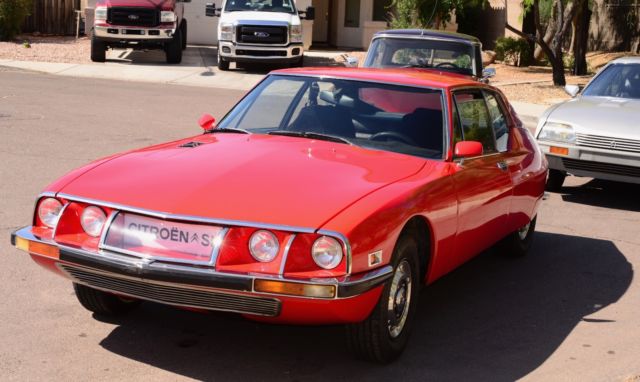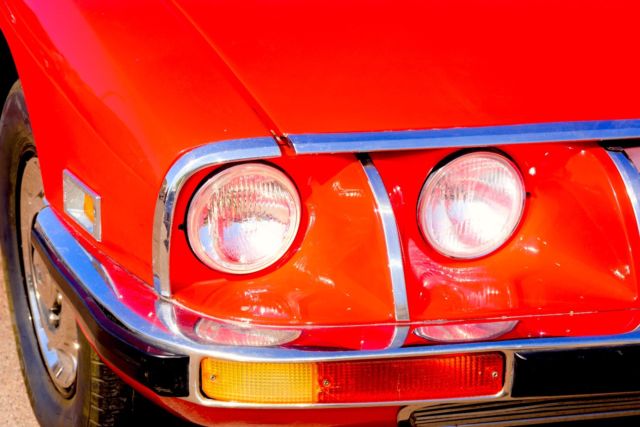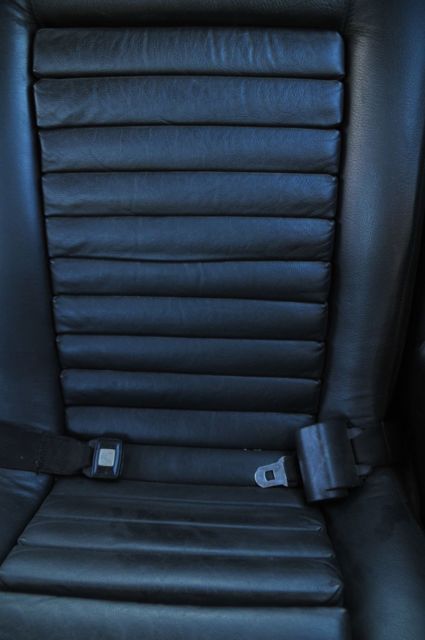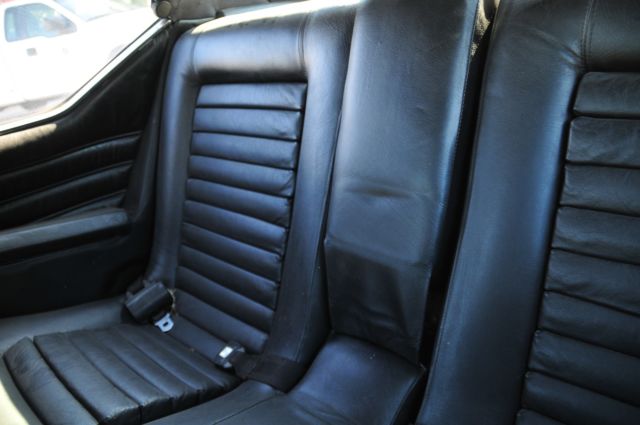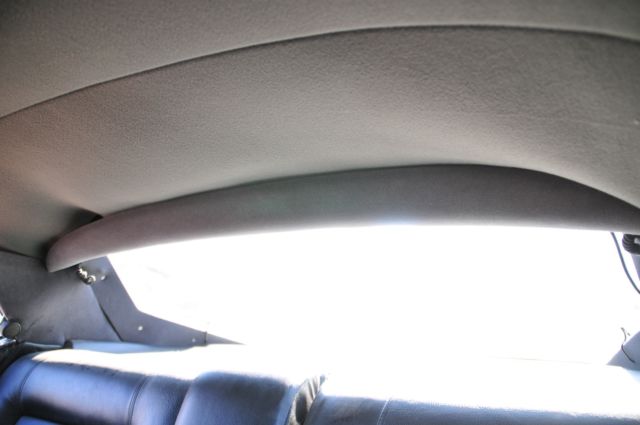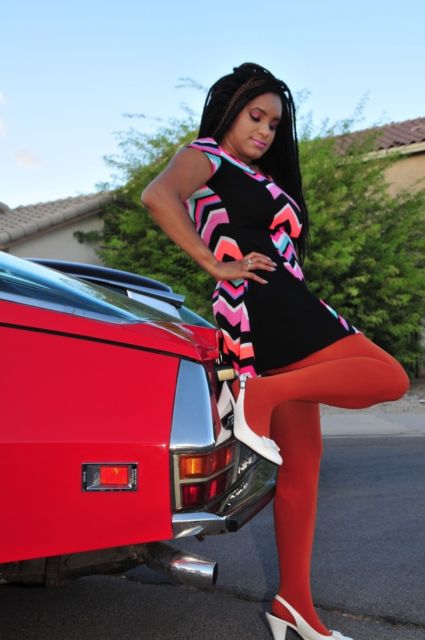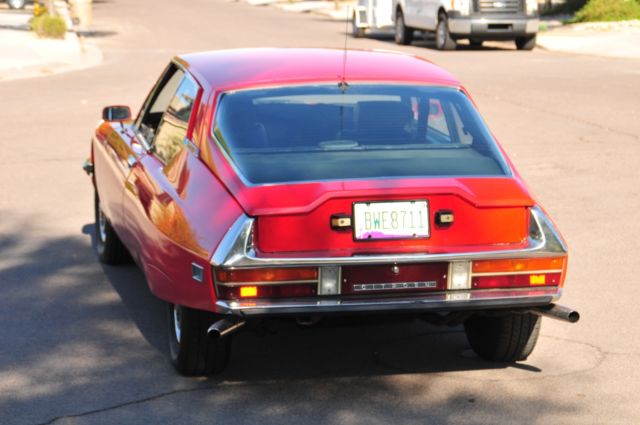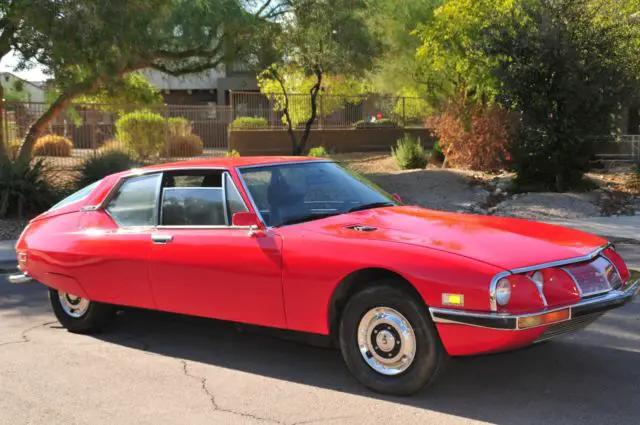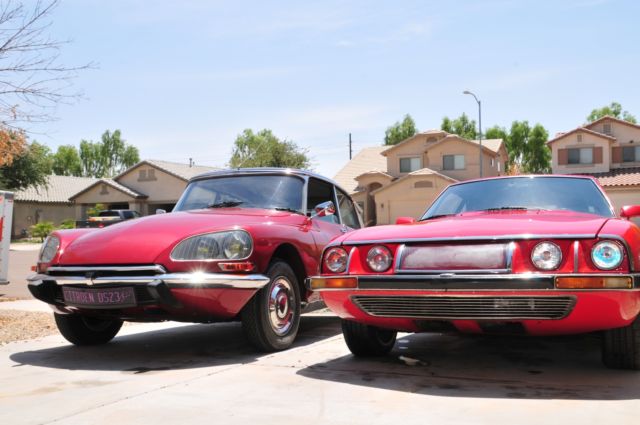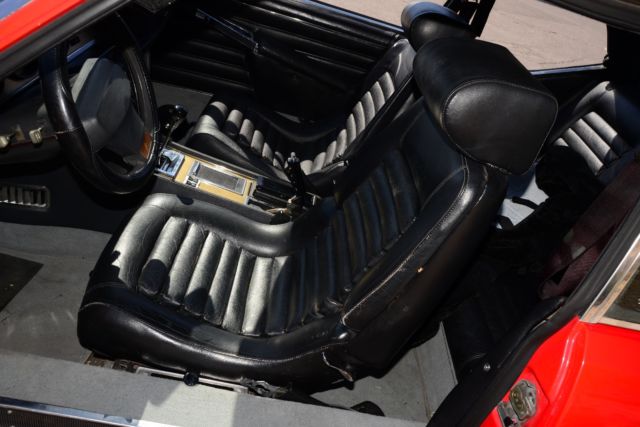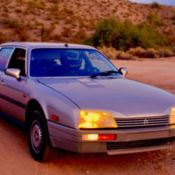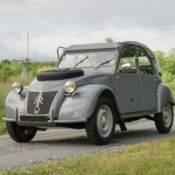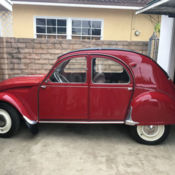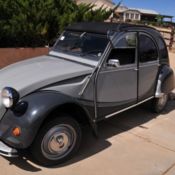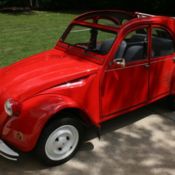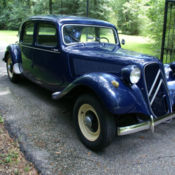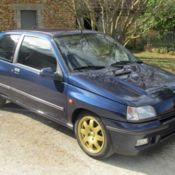citroen SM 73 5 Speed Rust Free great rare french car,Maeratti engine
1973 Citroën
Hello,I am a Citroen Collector I have loved these cars from my childhood on as my dad was a huge Citroen nut even sold the cars in the 1980s thru the grey market.I have owned many of these cars SM,DS,CX,2CV Etc so you can buy with confidence that everything that needs to be done or checked have been done.The Engine Runs great,Tranny Clutch all great Rust Free California car.The Ride is smooth like a magic carpet as it should be all the Spears and Hydraulics have been done,The car is reliable and serviced by a pro who understands and is familiar with these cars.The car gaskets do Not leak the timing chains are solid the exhaust is not smelly.The engine sounds like a solid Masseratti Engine the paint is in good shape the car gets lines of folks steering at it anywhere I go.The only thing that needs attention is the A/C It needs a new compressor I do have the old york one that ill throw in with the car should you want to rebuild it.Plain and simple unlike most SM s coming up for sale these days.This one is affordable and reliable not a car just out of storage needing you to spend thousands to make it right.This car is ready to drive anywhere good tires new battery no fuel leaks nice interior problem free.Oh and Yes its Red and black what combo could be better.If you are serious about buying please call me or if you have a question please call me if you have any question about me Most of the Citroen community know me and it can be verified.If you are worried about the quality of the car come to az drive it or I can have someone I sold a Citroen too verify my honesty.Im only selling because I have too many cars and well I need to slim down the collection =) call or text me 602 423 9942 anytime HarlanIf you want to know more about the sm google and you will know the sm is a stunning part of history
History[edit]
In 1961, Citroën began work on 'Project S' — a sports variant of the revolutionaryCitroën DS. As was customary for the firm, many running concept vehicles were developed, increasingly complex and upmarket from the DS.[2]Citroën purchasedMaseratiin 1968 with the intention of harnessing Maserati's high-performance engine technology to produce a trueGran Turismocar, combining thesophisticated Citroën suspensionwith a MaseratiV6.[3]
The result was the Citroën SM, first shown at theGeneva Motor Showin March 1970. It went on sale in France in September of that year. Factory produced cars were all left-hand-drive, although RHD conversions were done in the UK and Australia.
The thriving French luxury car industry was decimated by post-World War IIpuissance fiscaleregulation, which has hamstrung French manufacturers for decades, soFrancehad not had a production vehicle in this segment afterWorld War II.[4]The SM had an unusually small engine of 2.7 liters due to these regulations; it was the first response to the luxury/performance sector since the export orientedChryslerV8 engineFacel Vegain the late 1950s.[5]Citroën's flagship vehicle competed with high-performance GTs of the time from other nations and manufacturers, such asJaguar,Lotus,Ferrari,Aston Martin,Alfa Romeo,Mercedes-Benz, andPorsche.
The origin of the model name 'SM' is not completely clear. The 'S' may derive from the Project 'S' designation, the aim of which was to produce what is essentially a sports variant of theCitroën DS, and the 'M' perhaps refers to Maserati, hence SM is often assumed to stand for "Systeme Maserati" or "Sports Maserati". Another common alternative isSérie Maserati,[6][7]but others have suggested it is short for 'Sa Majesté' (Her Majesty in French), which aligns with the common DS model's nickname 'La déesse' (The Goddess).
The SM did not find a sufficient customer base in the European GT market, but much of the SM's technology was carried forward to the successfulCitroën CX, launched in 1974theDIRAVIsteering being the most obvious example. The same basic engine in enlarged 3.0L form (some in Italy had 2.0L) was used in Maserati's ownMerak(1,800 units) and later with some modification in theBiturbo(40,000 units).[8]The Merak,Khamsin, andBora, used Citroën's high-pressure hydraulics for some functions, and the Citroën gearbox in the Merak, during the Citroën-Maserati alliance.
Performance[edit]
Contemporary automotive journalists were effusive about the SM's dynamic qualities, which were unlike anything they had experienced before.[9]The SM provided a combination of comfort, sharp handling, and braking not available in any other car at the time.[10]The magazinePopular Sciencenoted that the SM had the shortest stopping distance of any car they had tested.[11]
Automotive journalists marveled at the resulting ability to travel for hours at 200km/h (120mph) in comfort.[12]In 1972Motorsport(U.K.) noted ..."that rare quality of being a nice car to be in at any speed, from stationary to maximum."[13]The touring range based on the SM's fuel economy and the large 90l (20impgal; 24USgal) fuel tank made long, fast, relaxing journeys possible.[14]
Because the SM had a small 170PS (130kW) engine, the acceleration was adequate rather than exemplary - some competitors were quicker. Some owners have fitted the similar sized 220PS (160kW)Maserati MerakSS engine, which does improve the driving experience considerably.[15]
Fuel consumption compares favorably to most competitors.
| 170PS (130kW) | 220km/h (140mph) | 8.5 sec | 8km/l (23mpg‑imp; 19mpg‑US)[16] |
| 192PS (141kW) | 202km/h (126mph) | 9.5 sec | 6.5km/l (18mpg‑imp; 15mpg‑US)[17] |
| 254PS (187kW) | 217km/h (135mph) | 7.5 sec | 4.4km/l (12mpg‑imp; 10mpg‑US)[18] |
| 193PS (142kW) | 200km/h (120mph) | 7.9 sec | 7.6km/l (21mpg‑imp; 18mpg‑US)[19] |
| 254PS (187kW) | 217km/h (135mph) | 6.8 sec | 5.5km/l (16mpg‑imp; 13mpg‑US)[20] |
| 215PS (158kW) | 190km/h (120mph) | 10.8 sec | 4.8km/l (14mpg‑imp; 11mpg‑US)[21] |
| 238PS (175kW) | 189km/h (117mph) | 9.7 sec | 4km/l (11mpg‑imp; 9.4mpg‑US)[22] |
The SM combines many unusual and innovative features, some of which are only just becoming commonplace on cars of today.[23]It borrows heavily from the innovations introduced on the DS, by includinghydro-pneumatic (oleo pneumatic)self-leveling suspension, andself-leveling lights that swiveled with the steering(except in the USA where these were illegal at the time).
The SM was Citroën's way of demonstrating just how much power and performance could be accommodated in afront-wheel drivedesign. This was novel, and many technical issues needed to be overcome, especially related totorque steer, where excessive steering feedback impacts control of the vehicle.
A solution was found - no road feedback at all - the driver points and goes, regardless of what the driven wheels are experiencing.[10][24]Hitting a pothole at high speed would not turn the steering wheel in the driver's hands.
Tailgate open -carbon-reinforced resinwheelsThis new type ofvariable assist power steeringhas since spread throughout the vehicle population.[23]DIRAVIas it was called, allowed great assistance to the motorist while parking, but little assistance at motorway speeds. The system adjusts the hydraulic pressure on the steering centering cam according to vehicle speed so that the amount of steering feel remained almost constant at any speed, counteracting the tendency of manual and ordinary power assisted steering to feel light at high speed. Thus the car turns easily at low speed, emphasized by high gearing given two turns lock-lock, and relatively more effort is required at higher speed.
If the driver released the steering wheel, then the steering would center back to the straight ahead position. It was geared for minimal steering input - with 2 turns from lock to lock, often described as like ago kart.
Many contemporary reviewers remarked that this system would take at least 50mi (80km) of driving to become familiar, but once the driver is accustomed to the system, then traditional steering feels old-fashioned.[25]
This steering was controversial at the time - exaggeratedstrong-armsteering inputs required for contemporary cars could cause abrupt manoeuvres in the SM.[9]When the SM was cast as a TV series regular on 1972'sThe Protectors, the lead actress refused to drive it, because of the familiarization required from the steering.[26]
TheDIRAVIsteering is self-centering and fully powered (as opposed to hydraulically assisted). This feature allows the front wheels to run near-zero caster, and means that there is no camber change as lock is applied, and also ensures that the maximum amount of tyre area is in contact with the road at all times.
The wiper mechanism, when on the "low speed" setting, is 'sensitive' to rain, by measuring the current needed to drive the wiper motor, while the steering column is adjustable in both height and reach.[23]
The braking system, adapted from the DS, employsdisc brakesat all four corners (the DS hasdrumsat the rear), with the front brakes beinginboard, and cooled via large ducts on the front underside of the car. The hydraulic braking pressure front to rear balance is self-adjusting according to the weight in the rear of the car, so on hard braking the entire car lowers evenly.[27]
Standard wheels are steel with stainless trims, but for the rigors of off-road racing,Michelindeveloped a unique solution - a lightweightcarbon-reinforced resinwheel, which became a factory fitted option. Theseplasticwheels weigh less than half the standard weight and were decades in advance of similar applications.[28]The construction method is similar to more the brittlefiberglassmaterial (some hobbyists even refer to them this way[29]), but the wheels contain carbon fibers, not glass fibers.[30]
Styling[edit]Designed in-house by Citroën's chief designerRobert Opron, the SM bears a vague family resemblance to both the DS and theMaserati Mistral. Like the DS, the SM retains the rear-wheelspats, and seen from above, the SM resembles a teardrop, with a wide front track tapering to a narrower rear track.
The SM was unusuallyaerodynamicfor its era, withKamm tailand lowdrag coefficientof 0.26.[31]The ventilation intake is located in a "neutral" area on the hood, which makes the ventilator fan regulate the interior ventilation at all road speeds.
The SM in profileMaserati MistralThe SM interiorWith its distinctlymodernistinfluence, the interior styling of the SM is as dramatic as the exterior. The small oval steering wheel is matched by oval gauges. The manual shift lever 'boot' is a highly stylized chrome gate. The seats are highly adjustable buckets with centre padding composed of many individual 'rolls'. High-quality materials are used throughout. The bonnet is aircraft grade aluminum, while the external bright work is stainless steel, rather than ‘cheaper’ chrome (except for "plastichrome" "SM" trim at the rear base of the rain gutter).
In 1970, it was a car of the future and the fastest front-wheel-drive car, with a factory-quoted top speed of 220km/h (140mph), and independent tests achieving as much as 235km/h (146mph). It was an example of the car as a symbol of optimism and progressive technology, similar to the SM's contemporary, theConcordeaircraft.[32]
The SM's design placed eleventh onAutomobile Magazine's 2005 "100 Coolest Cars" listing.
Motorsport[edit]Breadvan short-wheelbase racing variantThe SM won its first competitive outing, the gruelling 1971Rallye du Maroc. Citroën continued rallying the SM, eventually developing a "breadvan" short-wheelbase racing variant.
SM World, a marque specialist in Los Angeles, California, produced aturbochargedSM, which in 1987 set the land speed record for production vehicles in its class at theBonneville Salt Flats, Utah — traveling 202mph (325km/h).[33]
US exports[edit]A US-spec Citroën SM with round headlamps. The unusual looking green balls aresuspension components.The main export market for the SM was the U.S. In the U.S., the market forpersonal luxury carswas much larger than in Europe, with competitors like theCadillac Eldorado,Lincoln Mark IVandFord Thunderbirdalongside a large selection of Italian, British, and German imports. Nevertheless, the unique design of the SM made quite a splash and won theMotor TrendmagazineCar of the Yearaward in 1972: unheard of for a non-US vehicle at the time.[34]
The SM's sixheadlightset up was illegal in the U.S. at the time and consequently, U.S. specification cars were fitted with four fixed round exposed lamps. Also, the separate glass windshields of the headlights were illegal in the USA after 1967, which is why theDSdid not get them on USA cars when it was restyled for 1968, and theVW Beetleand Vanagon/Kombi andJaguar E-Typelost their headlight glass windshields at the same time.[35]
Despite initial success, U.S. sales ceased suddenly — Citroën expected, but did not receive, an exemption for the 1974 model year 5mph (8.0km/h)bumper regulationimposed by theNHTSA. The integralvariable height suspensionof the SM made compliance impossible. The final batch of 134 now illegal 1974 U.S. model SMs was shipped to Japan.[36]
Engines[edit]The SM was sold with a small, lightweight engine in various forms, designed from scratch byGiulio Alfieribut capable of being assembled on existingV8tooling. Because of this, the engine sported an unusual 90° angle between cylinder banks — a trait shared with the laterPRV V6. It was a very compact and innovative design that allowed the use of just one pattern for the cylinder heads and an intermediate shaft extended out to drive the auxiliaries.
The engine was aluminum and weighed just 300lbs (140kg), and always mountedbehind the front axle.[37]
| Model | Serial number | Engine | Displacement cm3 | Fuel supply | Horsepower PS SAE net | Transmission/ N° gears | Weight (kg) | Top Speed (km/h) | Years of production | Number produced |
| SM 2.7 | type SB | C114-1 | 2,670 | 3Weber carburetors 42DCNF | 170 | M/5 | 1.450 | 220 | 1970-72 | 7.133 |
| SM 2.7 Automatique | type SB | C114-1 | 3Weber carburetors 42DCNF | 170 | A/3 | 1.480 | 205 | 1972 | 675 | |
| SM 2.7 Injection | type SC | C114-3 | Electronic Injection BoschD-Jetronic | 178 | M/5 | 1.490 | 228 | 1972-75 | 3.500 | |
| SM 3.0 | type SD | C114-11 | 2,965 | 3Weber carburetors 42DCNF | 180 | M/5 | 1.450 | 225 | 1973 | 600 |
| SM 3.0 Automatique | type SD | C114-11 | 3Weber carburetors 42DCNF | 180 | A/3 | 1.480 | 205 | 1973-75 | 1.012 |
The size of the 2.7L engine was limited by Frenchpuissance fiscaletaxation, which made large displacement vehicles too expensive to sell in any quantity inFrance.[5]
Twin Turbo V6 SM developed bySM WorldinLos Angeles, California - achieved 202 mph (325 km/h) atBonneville Salt FlatsOne SM had a Maserati V8 motor - this was a heavily used test bed developed byMaseratifor the 1974Maserati Quattroporte II.[38]Despite developing 260hp (190kW), the car required relatively modest adjustments, and the performance made the SM into a true sporting car.[39]
One SM had a V6 twin Turbo - developed by specialistSM Worldforland speed recordtesting atBonneville Salt Flats- achieving 202mph.[33]
Smooth shifting 5-speedmanual transmissionswere fitted to most SMs.[40]A 3-speedBorg Warnerfullyautomatic transmissionwas an option in North America in 1972-73, and in Europe 1974-75.
The engine was also used in theMaserati Merakfrom 1972 to 1982. Later versions of the MerakSShad much larger valves and developed 220hp (160kW). TheLigier JS2sports caralso used thisV6 engine. The final SMs were produced in theLigierfactory inVichy.
Under new ownership,Maseratideveloped the 1981Biturbomodel, by applyingturbochargingto this engine, and sold 40,000 units.
Demise[edit]After the 1974 bankruptcy of Citroën,Peugeottook ownership of the company and in May 1975, divestedMaserati. Peugeot decided to stop building the SM, as sales were just 115 units that year.
Observers often attribute the demise of the SM to the1973 oil crisisandeconomic recession.[41]
While the oil shock certainly affected sales, it is useful to note that many far more profligate cars were introduced at the same time the SM ceased production, including thehydropneumatically suspendedMercedes-Benz 450SEL 6.9. Peugeot even introduced a V6 powered car of similar displacement and fuel consumption in 1975, the604. In the U.S. (the main export market for the SM), the SM was actually an economical vehicle relative to its competitors.[42]However, the U.S.National Highway Traffic Safety Administration(NHTSA) imposed new automotive design regulations in 1974, effectively banning the Citroën from the U.S. market.
As illustrated under production numbers, SM sales declined starting in 1972. This appears to be attributable to maintenance issues. Like an exotic Italian car, the Weber carburetors require frequent adjustment. Many engines experienced failure at 60,000km - it was unclear to most owners that theinterference engine designhastiming chainsthat require manual adjustment, an issue not corrected until long after production ceased.[43]The 90° engine timing was unfamiliar to mechanics in the 1970s. Only Buick (1962–66; 1975-) and Jeep (1966–71) used a V6 with 90° between banks of cylinders. Another issue that has been resolved with retrofit was unreliable ignition breaker cassettes.
Most vehicles require only generalist maintenance, where any competent mechanic can properly maintain the vehicle. Certain vehicles — like Citroëns andFerraris— require specialist care due to their unique design.[12]While a sturdy car if maintained rigorously, the SM did require two sets of specialist care — Citroën specialists, which are widespread in Europe, and a rarerMaseratispecialist, to keep the engine in tune.[44]Once potential buyers began to realize this, sales dropped precipitously.
TheQuai André-Citroënfactory on the banks of theSeine RiverinParisclosed in 1974. Both the DS and the SM had to find new manufacturing facilities. The final DS models were built at the newAulnay-sous-Boisfactory, while the SM was built by theLigiercompany.
Components of the SM lived on — in theMaserati Merak(engine, transmission) and theLotus Esprit(transmission (both mirror image)). The successfulCitroën CXcarried forward most of the SM's dynamic qualities, including the trendsettingspeed sensitive power steering.
Production numbers[edit]A total of 12,920 SMs were produced during its lifetime. Sales declined steeply each year following the first full year of production. The North American market took 2,400 cars, in 1972 and 1973.[45]
| Sales Change | U.S. and Canada>>TOTAL>>|||
| 868 | - | 0 | 868 |
| 4,988 | 475% | 0 | 4,988 |
| 2,786 | (44%) | 1,250 | 4,036 |
| 1,469 | (47%) | 1,150 | 2,619 |
| 294 | (80%) | 0 | 294 |
| 115 | (61%) | 0 | 115 |
The factory always produced just one body style — aLHDtwo-doorfastbackfixed head coupé, but the design did inspire a variety of variants, none produced in any quantity.
1972 Citroën SM présidentielle - inaugural drive byGeorges Pompidouand QueenElizabeth II1975 Citroën SM Mylord - sold at auction in 2014 for €548,320 (US$754,220)1974 Citroën SM OpéraCoachbuilderHenri ChapronfromLevallois-Perretproduced several very collectible variants of the SM.
French Presidents fromGeorges PompidoutoJacques Chirachave enjoyed touring Paris in the two 4-door convertible Citroën SMprésidentiellemodels, sharing them with such notables as QueenElizabeth IIandPope John Paul II. These manual transmission cars have special low gearing suitable for parade use.
Chapron also created five convertibles (SM Mylord) and seven sedans (SM Opéra). Original copies of these rare models are very valuable - the lastMyLordsale recorded was for €548,320 in February 2014.[46]Some SM owners have made their own copies of the SM convertible in particular.[47]Unlike the DS, the factory never authorized a convertible model, as Citroën felt the roof was integral to the structure of the SM.[48]On the SM, the roof and rear quarter panels were welded on.
In 1971,Heuliezproduced two examples of atarga topconvertible, the SM Espace.[49]
Just before the SM's demise, Citroën produced several short-wheelbase racing versions with squared-off rear sections and highly tuned engines — known as the "breadvan" model.
In the UK, three official RHD prototypes were constructed byMiddleton Motors, a Citroën dealer inHertfordshire, England. At least one of these prototypes still survives.
In Australia, 12 cars were converted to RHD byChappel EngineeringinMelbourne, Australia forDutton's(the Australian importer of Citroën at the time).[50]Cars are still being modified with RHD controls and dashboards for the Australian market, where RHD is mandatory.
Fruaalso proposed a concept car based on the SM, a front-wheel-drive car that closely resembled the mid-engineMaserati Merak.
In the spring of 1974, Maserati created a special 260hp (190kW) 4.0L V8 engine based on the latest C114-11 engine variant. This engine, installed in a standard SM, tested over 12,000 kilometers. The engine was then removed and preserved, while the rest of the car was destroyed byAlejandro de Tomaso. The SM Club of France created an exact replica of this car using the actual engine from the original and displayed it at theRétromobile2010 show.[38]
Unfortunately, the intended recipient never received this V8. TheMaserati Quattroporte IIwas aMaserati-badged, four-door variant of the SM with an angular body and lengthened floorpan. The six headlights were retained and the later 'SS' version of the engine fitted. This model was introduced at the time of Citroën's bankruptcy in 1974. It entered production in 1976 and only twelve were produced between then and 1978.[51]
Prominent owners[edit]The dramatic dashboard was shared with theMaserati MerakLike theCitroën DS, the SM has had many celebrity owners.[11]General Secretary of the Communist Party of theUSSRLeonid Brezhnev,[52]Rolling StonesbassistBill Wyman,[53]Adam Claytonof the rock groupU2,[54]and EmperorHaile Selassie I of Ethiopiaeach drove SMs, while Ugandan dictatorIdi Aminhad seven of them.[55]The Shah of Irandrove an SM.
ActorsLorne GreeneandLee Majors, composerJohn Williams, authorGraham Greene, and former Mauritian QC and Politician Sir Gaetan Duval (1930–1996), football playerJohan Cruijff, drummerCharlie Watts,Cheech & Chong'sCheech MarinandThomas Chong,[56]motorcycle racerMike Hailwood,[57]composerJohn Barry, & musicianCarlos Santana, all owned SMs as well.[58]PopularYugoslavandCroatiansingerMišo Kovačhad his very own golden SM. Television host and comedianJay Leno's SM is seen frequently in the background of hisJay Leno's GarageYouTubevideos.[59]
Media appearances[edit]The SM has made prominent appearances in several films and TV series:
- Burt Reynoldsescapes a fleet ofpolice carsbehind the wheel of a stolen SM in the 1974 filmThe Longest Yard. As he leaves the house, the female owner of the SM shouts "don't take my Maserati!".[60]At aquayside, Reynolds gets out of the, nudges it into gear, and it drives into the water. In real life, Reynolds liked the car so much that he gave a 1973 SMAutomatique[61]to his friendDinah Shore.[62]
- Janet Jacksonappears in an SM with a red leather interior in the music video for the 1998 songI Get Lonelyfrom theVelvet Ropealbum.
- Patrick McGoohandrives an SM in a 1975 episode of the American television seriesColumbo("Identity Crisis", Season 5, Episode 3)
- Gerry Anderson's 1971 television seriesThe Protectorsfeatured a platinum blue SM.
- The SM makes an appearance a gangster-vehicle (also used in a abduction by) in Episode 47 "Die Rechnung wird nachgeliefert" of the successful German crime seriesTatort.
- In the 1980 Spanish film "Navajeros", which tells the story of a famous mid 70s juvenile delinquent nicknamed "El Jaro", the main actor (José Luis Manzano), steals a Citroën SM in order to impress a girl (Verónica Castro).
- Ben Stilleris kidnapped in a green SM in the 2001 filmZoolander.
- An SM is used in an attempted kidnapping in the 1975Charles BronsonfilmBreakout.
- Sven VäthandMiss Kittindrive a modified Citroën SM in their video from the single "Je t'aime... moi non plus".
- Norwegian composerKaadaand his music video 'No You Don't' features an SM.
- 2013 videogameGrand Theft Auto Vfeatures a fictional car named the Lampadati Pigalle, part of the "I am not a hipster" update, which is loosely based on the SM.
- Condition: Used
- Make: Citroën
- Year: 1973
- Mileage: 82,741
- VIN: 00SD0283
- Vehicle Title: Clear Want to buy? Contact seller!
